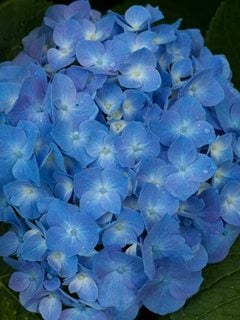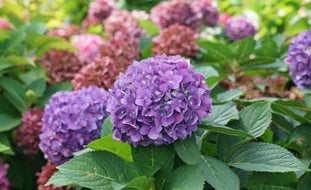Hydrangea Types
Compare the different types of hydrangeas commonly grown in American gardensSome sources say there are 23 species of hydrangea, others claim there are 49 and still others say there are as many as 80! However many there are, only six types are commonly grown in American gardens. Check out the information below to compare their characteristics.

Let's Dance® Blue Jangles® produces flowers on both old and new wood throughout the season. Photo by: Proven Winners.
Botanical name:
Hydrangea macrophyllaZones:
Most 6-9, with some varieties hardy to Zones 4-5 with winter protectionHeight/Spread:
6-10 feet/6-10 feetExposure:
Part to full shade. Full sun only with consistently moist soil.Color:
White, pink, blue, purple or redBloom time:
June to OctoberPruning:
Generally needs little pruning, just tidying up. Remove dead wood as spring growth begins, being careful of flower buds.Other:
- Sometimes called French hydrangeas, mopheads or hortensias.
- Newer varieties bloom on old and new growth, and older cultivars bloom on old wood.
- Flower color depends on soil composition (see Changing Hydrangea Color)
- Good for cut flowers.
- Two flower types: Mophead with large globe-shaped flower heads, and lacecap with flattened head of small flowers surrounded by larger flowers.
- Common selections: Endless Summer, ‘Nikko Blue’, ‘Tokyo Delight’, Pistachio
Learn more about how to grow bigleaf hydrangeas.

'Annabelle' is graced with huge white flower heads for two months in summer. Photo by: Karin Jaehne / Shutterstock.
Botanical name:
Hydrangea arborescensZones:
3-9Height/Spread:
3-5 feet/3-5 feetExposure:
Part shade. Full sun only in consistently moist soil.Color:
White to pinkBloom time:
June to SeptemberPruning:
Prune close to the ground every other year in late winter to keep neat and encourage new growth.Other:
- Blooms on new growth.
- Intolerant of drought.
- May die to the ground in harsh winter.
- Native to Eastern North America
- Common selections: Incrediball, Invincibelle series, ‘Annabelle’
Learn more about how to grow smooth hydrangeas.

The flowers of ‘Limelight’ start off green, then change to white, finally turning pink when the season segues from summer into fall. Photo by: Dmitry Trubitsyn / Shutterstock.
Botanical name:
Hydrangea paniculataZones:
3-8Height/Spread:
8-15 feet/6-12 feetExposure:
Full sun to part shade.Color:
WhiteBloom time:
July to SeptemberPruning:
Prune as needed in late winter/early spring, promotes larger flower clusters.Other:
- Blooms on new growth.
- The most winter hardy variety.
- Cone-shaped flower heads.
- Common selections: ‘Limelight’, Pinky Winky, Vanilla Strawberry, Bobo, Little Quick Fire, ‘Grandiflora’ (commonly called PeeGee)
Learn more about how to grow panicle hydrangeas.

In addition to handsome oaklike foliage and attractively peeling silvery brown bark, Snowflake features footlong, pyramidal, drooping heads of sterile flowers that look like stacked stars. Photo by: Lee Anne White.
Botanical name:
Hydrangea quercifoliaZones:
5-9Height/Spread:
6-8 feet/6-8 feetExposure:
Full sun to part shade.Color:
White to purple/pinkBloom time:
July to SeptemberPruning:
Prune after flowering as needed, cut back winter-damaged stems in early spring.Other:
- Blooms on old wood.
- Native to the US, found in woodlands throughout the Southeast.
- Good fall color, flowers change from creamy white to dark rose and leaves to a combination of orange, yellow, red, purple, and burgundy.
- Common selections: ‘Pee Wee’, ‘Ruby Slippers’, Snowflake
Learn more about how to grow oakleaf hydrangeas.

Expect a summer show of creamy white, fragrant lacecap flowers draped along layered branches. Photo by: MBP-Plants / Alamy Stock Photo.
Botanical name:
Hydrangea anomala ssp. petiolarisZones:
4-8 (doesn't thrive in zone 7)Height/Spread:
30-40 feet/5-6 feet (grown upright)Exposure:
Part to full shade.Color:
WhiteBloom time:
May to JulyPruning:
Prune lightly after the vine is done flowering to control its height and width. Heavy pruning to rejuvenate a damaged plant should be done in late winter or early spring.Other:
- Can cover up to 200 square feet if unsupported and grown along the ground.
- Grow against walls (brick, stone, or wood), on arbors, fences or over low walls.
- Common selection: ‘Miranda’
Botanical name:
Hydrangea serrataZones:
6-9Height/Spread:
2-4 feet/2-4 feetExposure:
Part shadeColor:
Pink or blueBloom time:
June to AugustPruning:
Prune after flowering as needed, cut back winter-damaged stems in early spring.Other:
- Blooms on old wood.
- Similar to H. macrophylla (lacecap varieties), but more compact, with smaller flowers and leaves.
- Good choice for container planting due to its size. (See more dwarf hydrangeas.)
- Common selections: ‘Blue Billow’, Tuff Stuff, ‘Bluebird’
Learn more about how to grow mountain hydrangeas.












